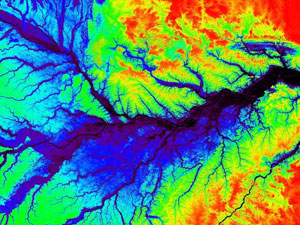Is the Amazon longer than the Nile?
Is the Amazon longer than the Nile?
mongabay.com
June 18, 2007
Brazilian researchers claim they have evidence proving that the Amazon is the longest river in the world, some 65 miles (105 km) longer than the Nile, reports BBC News.

A topographic map of a section of the central Amazon River Basin near in Manaus, Brazil. Dark blue indicates channels that always contain water, while lighter blue depicts floodplains that seasonally flood and drain, and green represents non-flooded areas. Image courtesy of the Global Rain Forest Mapping Project. |
Guido Gelli, director of science at the Brazilian Institute of Geography and Statistics, said researchers have traced the origin of the Amazon to Mismi, a snow-covered mountain in southern Peru. The generally accepted origin of the Amazon is further north, making it the second longest river after the Nile, which is 4,157 miles (6,690 km) long.
Geographers have long bickered over the length of the world’s most important rivers, the origins of which are notoriously difficult to determine. The length of the Amazon is usually listed at 3,969 miles (6,387 km).
In terms of volume, there is no doubt that the Amazon is the world’s largest river. It’s volume is greater than that of the next eight largest rivers combined.
The new research was sponsored by the National Geographical Institute of Peru and the Brazilian Institute of Geography and Statistics. The results will likely be challenged.
Climate concerns
Tracing the origin of the Amazon river back to a glacier highlights the vulnerability of the river system to climate change. Glaciers and snowmelt in the Andes are the source for as much as 50 percent of the water in the upper Amazon, yet global warming puts these at risk: the Peruvian government estimates that the country’s glaciers have shrunk by more than 20% in the past 30 years and could disappear in the next 40. Further downstream, models show that climate change, combined with deforestation, will leave the Amazon rainforest considerably drier by 2050, further impacting water availability in the river basin.














